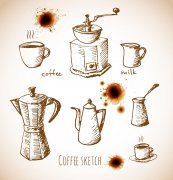How to make perfect Italian espresso World Barista Competition (WBC) champion Italian matching beans
Winner of WBC and current referee of WorldCoffee Events. He is a co-founder of Prufrock Cafe and runs a barista training academy near Prague, Czech Republic.
Me: Greetings, Gwilim! Thank you for coming here to discuss espresso with me. My first question is: What makes perfect espresso?
Gwillim: That's a good question. A lot of baristas have asked me the same question. My answer: only coffee you think is good espresso. What others call "perfect coffee" may mean nothing to you. For me personally, I use the WBC Sensory Rating Scale to objectively judge espresso coffee. I like the perfect balance between sour, sweet and bitter flavors, as well as the texture and aftertaste of coffee. I think espresso is really good coffee only if it has balanced taste, mild bitterness, medium acidity, rich taste, long lasting aroma and sweet taste. If coffee is not sweet, there is no balance between various flavors, coffee purity, smooth, lasting taste and pleasant aftertaste is also an important criterion for me to judge coffee quality. Truth is, I've never tasted perfect espresso. Usually, coffee lacks sweetness or a lingering aroma. If I have to define perfection, I think sweetness and aftertaste are the most important.
Me: What should we pay attention to when making espresso coffee?
Gvelim: In order, they are: high quality fresh coffee beans, bean grinder blades sharp enough, and filtered water. Be sure to change the filter elements regularly. To ask about taboos in the Italian espresso process, I think there are two points:
1. Uncleaned coffee or bean grinder
2. Coffee powder is not evenly distributed in the filter bowl
It's not enough just to smooth the ground coffee with your fingers. You must ensure that the coffee powder is evenly distributed at the bottom and top of the bowl. I gave up hand-smoothing coffee a long time ago. Now I use the horizontal + vertical smoothing method to ensure that the coffee powder is evenly distributed before pressing.WBC coffee making instructions have some reference value, but I think it is not enough to just follow the steps in the guide, I have seen a lot of baristas who can make high quality coffee in the competition, but in my opinion, they are not qualified to work at Prufrock.
Me: What are your parameters based on? Taste, extraction, time or?
Gwillim: I set the parameters according to the proportion of water powder. If there is still a problem with the taste of coffee, I will check the extraction time. Whenever I get a new coffee bean, I try it at three ten percent ratio. The set ratio is usually around 50% EBF (coffee powder: total coffee weight =1:2). I'll adjust the total weight of the coffee based on the sweetness of the coffee to increase the sweetness of the coffee. In the past, I used to fret all day about the taste of coffee, but since I started using the 3-step gouache ratio test, I can easily adjust and determine the best way to make it. I don't think extraction time has much effect on coffee quality, as long as you know the recipe, even a 4-second error is perfectly fine. At my training institute, I ask my students to make coffee in 19-24 seconds; when I travel to other countries, I make coffee in 27 seconds; at Prufrock, the clerk can even make coffee in 36-40 seconds. If I want my coffee to taste purer, I'll make it shorter; if I want it to taste richer, I'll make it longer, and avoid caffeine taking too long to make it with a burnt taste that disrupts the balance of flavors. Sometimes I measure coffee extraction, but most of the time it's unnecessary. If you make coffee long enough, you can probably guess the extraction level without using a laser scatterometer.

Important Notice :
前街咖啡 FrontStreet Coffee has moved to new addredd:
FrontStreet Coffee Address: 315,Donghua East Road,GuangZhou
Tel:020 38364473
- Prev

The five most popular kinds of coffee in the world. Latte-Latte pressed coffee-French Pres
1. Latte-Latte first let's take a look at the exquisite, delicate latte. Latte is more than just a coffee with milk. First of all, lattes must be made from espresso rather than drip coffee. Second, the latte is divided into three layers, the top layer is milk foam, the middle layer is evenly mixed milk, the bottom is Italian espresso. Strong in Italy
- Next
The effect of stirring on the extraction of hand-brewed Coffee Standard steaming method
The main results are as follows: 1, in the steaming stage, the amount of water is the standard of direct water injection and stifling; however, if the initial amount of stifling is 50 grams (corresponding to 20 grams of powder), then the whole instantaneous water trend chart will be different; the amount of water injected in the steaming stage will determine the instantaneous water trend in the later stage, so the instantaneous water trend chart in the article is also
Related
- Beginners will see the "Coffee pull flower" guide!
- What is the difference between ice blog purified milk and ordinary milk coffee?
- Why is the Philippines the largest producer of crops in Liberia?
- For coffee extraction, should the fine powder be retained?
- How does extracted espresso fill pressed powder? How much strength does it take to press the powder?
- How to make jasmine cold extract coffee? Is the jasmine + latte good?
- Will this little toy really make the coffee taste better? How does Lily Drip affect coffee extraction?
- Will the action of slapping the filter cup also affect coffee extraction?
- What's the difference between powder-to-water ratio and powder-to-liquid ratio?
- What is the Ethiopian local species? What does it have to do with Heirloom native species?

